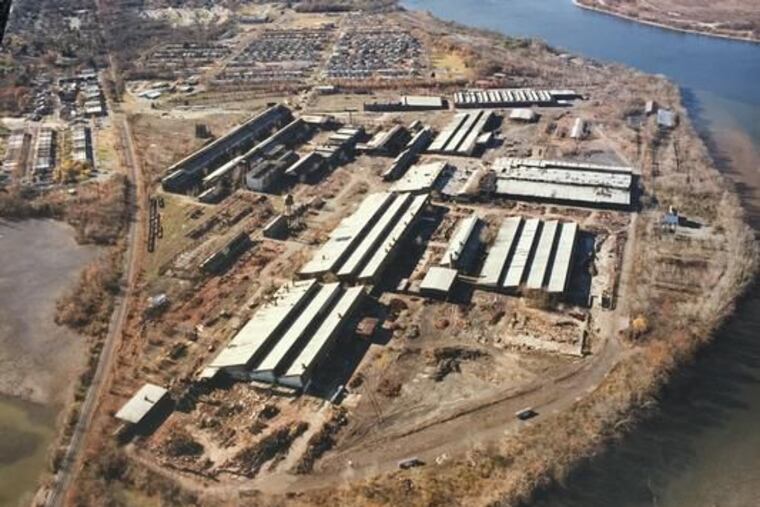Four toxic sites in Montco and South Jersey will get federal cleanup money
Two of the Superfund sites announced for more cleanup action are in Montgomery County, one is in Burlington County, and a fourth is in Gloucester County.

Polluted water wells, noxious ash cinders, sludge-filled lagoons, and a fouled stream are just parts of four local Superfund sites contaminated during the 20th century that will get new money for cleanups, said the U.S. Environmental Protection Agency.
One site, Roebling, is associated with the family behind some of the most iconic bridges in the country, including the Brooklyn and Golden Gate Bridges.
EPA officials announced Tuesday that 25 Superfund sites across the country will get more than $1 billion for new cleanups under the latest round of funding from the Bipartisan Infrastructure Law signed by President Joe Biden in 2021. Funding will help continue cleanups already in progress at 85 other Superfund locations. It is the third and final round of funding under the law.
“Today’s funding announcement continues EPA’s historic investment in the remediation of our nation’s most contaminated sites,” said EPA Mid-Atlantic Regional Administrator Adam Ortiz.
The contaminated sites include toxic chemicals from manufacturing facilities, processing plants, landfills, mining, and other operations.
Projects in the immediate Philadelphia region include:
Salford Quarry, Lower Salford Township, Montgomery County
The 3-acre quarry site was contaminated starting in the 1950s when a waste disposal business used it to dump industrial, commercial, and residential waste. That waste included fly ash and cinders from a coal-fired power plant. From 1963 to 1980, a tile manufacturer used the quarry to dispose of sludge, sediment, and scrap tiles. The operations contaminated soil, surface water, and groundwater with hazardous chemicals. Salford Quarry was named a Superfund site in 2009 after years of litigation. Investigation and cleanup of the site are ongoing.
New funding will go toward installing a wall below the surface of groundwater as well as an impermeable cap as a way of burying the contamination.
Baghurst Drive, Harleysville, Montgomery County
In 1999, the Montgomery County Health Department discovered that a groundwater plume from an unknown source was contaminated by volatile organic compounds (VOCs) at the site. The plume affected a community of single-family homes, a number of which drew their water from a community well. About 27 homes were supplied with bottled drinking water until they were equipped with carbon filtration systems. The site was named a Superfund in 2014.
With the additional funding, the EPA will use a technology that heats up soil and bedrock to a temperature that allows for the source of contamination to be removed from groundwater. It’s a step toward making the well water drinkable again.
Roebling Steel, Florence Township, Burlington County
The 200-acre Roebling Steel Co. made steel wire and cable next to the Delaware River until it closed in the 1980s. In the process, large areas surrounding the building were contaminated. Then, a fuel and iron company took over, adding to the pollution. Soiled, sediment, groundwater, 70 buildings, two sludge lagoons, and a landfill were contaminated. The soil contained heavy metals such as lead, chromium, and cadmium. The Delaware River, and other waterways and wetlands were contaminated with lead, chromium, copper, and hazardous oils and tars. The buildings were contaminated by dust and asbestos.
The new $2 million in funds will be used to cap 100 acres of the site, including a slag, or metal waste, area. The work includes a system for stormwater drainage.
Matlack Inc., Woolwich Township, Gloucester County
The 79-acre property is bordered by the 1.25-mile Grand Sprute Run stream that drains into Raccoon Creek, part of the Delaware River watershed. The company’s former Swedesboro Terminal was on the northern portion of the parcel. Trucks and tankers that transported hazardous substances were cleaned at the site from 1962 to 2001. Cleaning solution was dumped in an unprotected lagoon, which was later filled with debris. The location was listed as a Superfund site in 2013. The New Jersey Department of Environmental Protection (DEP) owns the western part of the property, which is part of the Raccoon Creek Wildlife Management Area.
The new round of $30 million in funding for the Matlack site includes using thermal treatment technology to extract vapors from soil and groundwater, which will then be sampled to test efficacy.
Other Pa. Superfund site cleanups
Other new cleanups announced Tuesday include two others in Pennsylvania: Jackson Ceramix Inc. in Jefferson County and Valmont TCE Site (Former Valmont Industrial Park) in Luzerne County. And they include the Raritan Bay Slag site in Middlesex County, N.J.
“Superfund sites threaten public and environmental health across the country, but with today’s announcement, the Bipartisan Infrastructure Law is continuing to deliver on the promise we made to clean up backlogged sites and give our communities the peace of mind they deserve,” Rep. Frank Pallone Jr., the ranking member of the House Energy and Commerce Committee, said in an EPA statement. “For dozens of communities, today’s funding is a welcome assurance that help is on the way.”